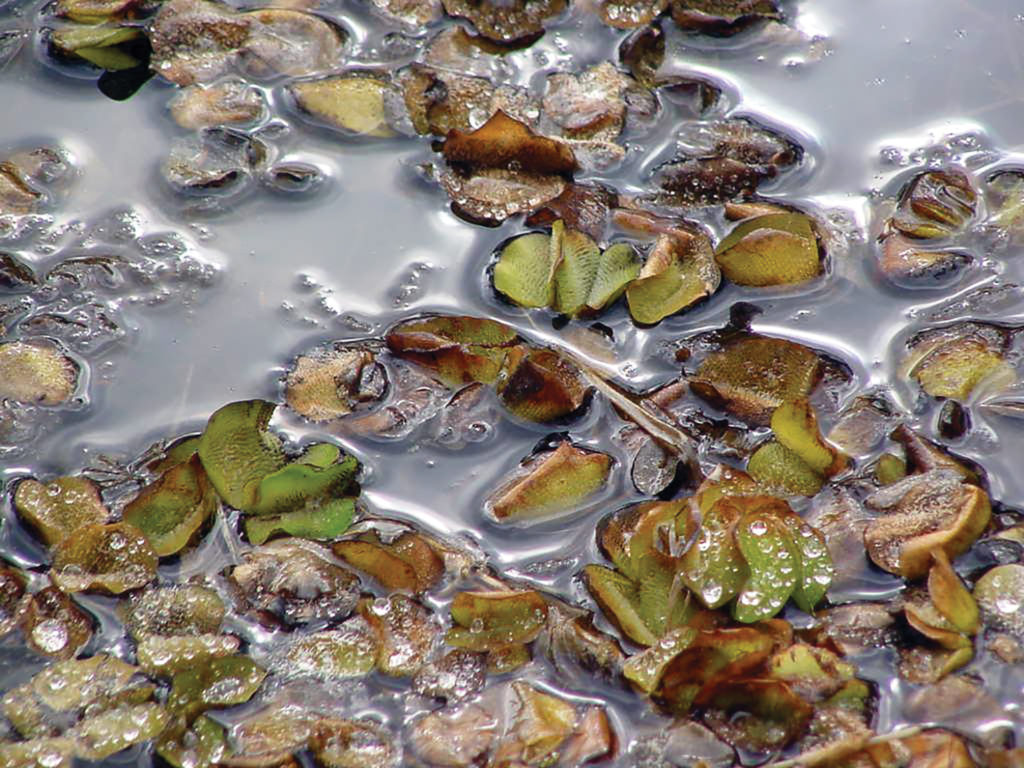The Mobile Area Water and Sewer System closed Big Creek Lake when it discovered giant salvinia growing in the 3,600-acre reservoir near Semmes.
MAWSS officials sprayed the lake with herbicide to kill the noxious plant and built a boat washing facility near the only landing on the water-supply reservoir. The impoundment on the Escatawpa River watershed partially reopened to fishing and boating in June 2022 after remaining closed for 10 months. People must wash their boats and trailers before launching into Big Creek Lake to curtail the spread of the invasive plant.
“We sprayed the giant salvinia with an EPA-approved product,” says Bud McCrory, MAWSS director. “We’ll never get giant salvinia out of the lake completely, but we’re going to try to mitigate how it spreads. The boat washing will help reduce our risk at some percentage.”
Native to southeastern Brazil, this aquatic fern grows extremely rapidly. In ideal conditions, it can double in size in less than a week and quickly dominate portions of any freshwater system. Once established, giant salvinia chokes out native plants and reduces dissolved oxygen levels in the water.
“Giant salvinia grows at such a high rate that it shades out the bottom,” says Dave Armstrong, the Aquatic Nuisance Species Coordinator for the Alabama Division of Wildlife and Freshwater Fisheries. “It’s amazing how deep this stuff will grow. It grows to where there’s very little sunlight. It grows in layers upon itself until it completely fills in a small pond from top to bottom.”
One of the most aggressive aquatic plants, this fast-growing exotic can grow so thick that boats cannot pass. It blocks the sunlight, killing everything beneath it that depends upon sunlight to survive.

“When giant salvinia covers the surface, it kills the plankton,” Armstrong says. “All fish require plankton, at least when they’re young. Small fish, prey for larger fish, eat plankton. If the plant reduces phytoplankton and zooplankton in a system, fish won’t get enough food to it.”
This noxious invader currently exists in at least 11 states including all five Gulf Coast states. In Alabama, people first discovered giant salvinia growing in two ponds in Auburn in 1999. Soon after that, people identified it in the Tallapoosa and Chattahoochee watersheds as well as ponds in Lee, Montgomery, Greene, Pickens, Russell and Sumter counties.
More recently, researchers detected it in Gainesville Reservoir and backwater sections of the Tombigbee River. A pond in Autauga County contained a bad infestation. Giant salvinia in the Elk River, which flows into the Tennessee River, probably died out from cold. As a tropical plant, giant salvinia thrives in warm water, but a hard freeze could kill it.
“The occurrence of giant salvinia is sporadic in Alabama,” Armstrong says. “We eliminated it in certain areas and weather took care of it in other places. We’ve had reports of it in the Mobile-Tensaw Delta in extreme southern Alabama. I would not be surprised if it’s in some backwater areas with limited flow in the delta. It’s a freshwater plant so it probably can’t handle too much salt like in Mobile Bay.”
The plant probably came to the U.S. for aquariums or water gardens. When people no longer wanted to maintain an aquarium, they probably dumped it into the nearest stream, pond or lake. In addition, flood conditions can overflow ponds and water gardens, washing the plants into nearby rivers.
Giant salvinia can survive out of water for up to a year. In addition, the plant clings to boat hulls and trailers. When someone launches a boat carrying the plant into another system, the invader multiples prolifically in its new home. People also theorize that particles can attach to the legs and feet of wading birds like herons and egrets. Once established, the plant rapidly takes over portions of that waterbody.
“The main way this plant spreads is by sticking to boat hulls and trailers,” Armstrong says. “It’s so clingy it’s almost like Velcro. Little eggbeater-like hairs on the leaves grab onto anything. Birds ingest it and spread it that way. Once it gets into a system, spraying masses of it is the only way to control it.”
To help curb the spread of giant salvinia and other noxious exotic plants, always wash boats and trailers or anything else before launching into another waterbody. To report giant salvinia infestations, contact Dave Armstrong at 251-331-7050 or email [email protected]. See giant salvinia on outdooralabama.com and other internet sources.
John N. Felsher is a professional freelance writer who lives in Semmes, Ala. He also hosts an
outdoors tips show for WAVH FM Talk 106.5 radio station in Mobile, Ala. Contact him at [email protected] or through Facebook.




